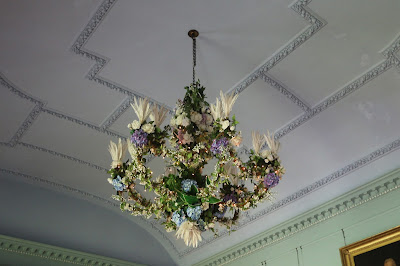* It's only open for a relatively short time each year - precisely 100 days to conform to an arrangement they have with Plymouth City Council ("we'll look after your portraits as long as you grant the public access for a 100 days each year").
* It's reputed to be one of the longest continually occupied sites in the UK - starting some 1500 years ago in the late Iron Age, through an Augustinian priory/monastery founded in the fifth century to the 500 year occupancy of the family of the present owners, Lord and Lady St Germans.
* It has an amazing mural painted over a 20 year period by a well known local artist, Robert Lenkiewicz.
* It has an extensive collection of paintings by Sir Joshua Reynolds, another local artist but probably better known than Lenkiewicz.
* There is a tenuous family connection in that some of Mrs P's forebears worked on the Eliot Estate, in fact one of her x4 great grandmothers died on an estate farm almost within sight of the house.
So, many reasons to visit and we were glad that we did. Extremely friendly and informative staff and a nice tea in the main dining room. But I much prefer Mrs P's scones. I did have a little frisson of excitement as we had tea as I thought that we were being served by the lady of the manor, Lady St Germans. It struck me as fitting that we should be served by the family that Mrs P's forebears had waited on so long ago. Sadly, it was not to be. Bring on the Revolution!
 |
| The first glimpse of Port Eliot as we came down from the car park in a nearby field. |
 |
| The west doorway of the church with its typically Norman carvings. |
 |
| Looking up into the bell tower at the bell ropes. |
 |
| Inside the church looking east. A few years ago I sang at a choir festival here and it was one of the coldest experiences of my life. |
 |
| Looking up to the rather fine barrel vaulted ceiling. |






2 comments:
Robert Lenkievicz could be kind and helpful. In the seventies he had a large exhibition of his paintings with the theme 'Relationships', so I invited him to give an illustrated talk to our Psychology students at Plymouth Poly (University). Knowing him of old, the authorities agreed provided that the posters included warnings about likely obscene language and 'very explicit' themes, and that students would attend 'at their own risk'. Naturally it was an all-time sellout, and talked about for a long time afterwards. He had voluntarily stayed on long after the talk to answer questions and discuss his paintings. I also discovered to my certain knowledge that subsequently he had engaged in Ugandan Discussions with at least three of the students attending. (Clue: it is an old Private Eye code). A very clever, talented and rather wild artist. Most of all, great fun.
For those unfamiliar with Private Eye euphemisms, 'Ugandan Discussions' refer to illicit carnal relationships. I forget the people involved but I think it originates from someone claiming they were in the bedroom 'discussing the situation in Uganda' when caught red-handed.
Post a Comment